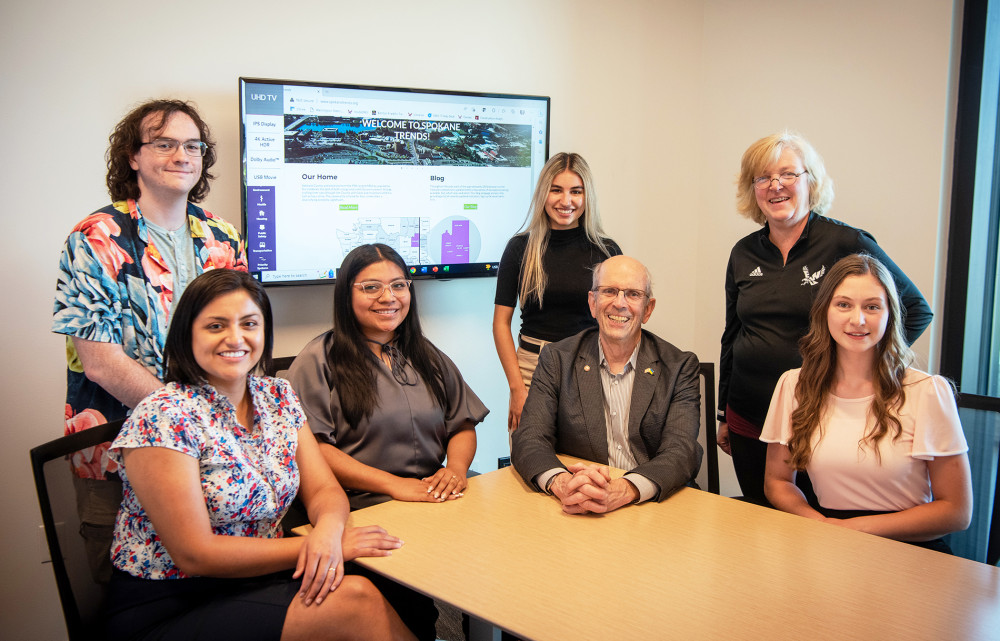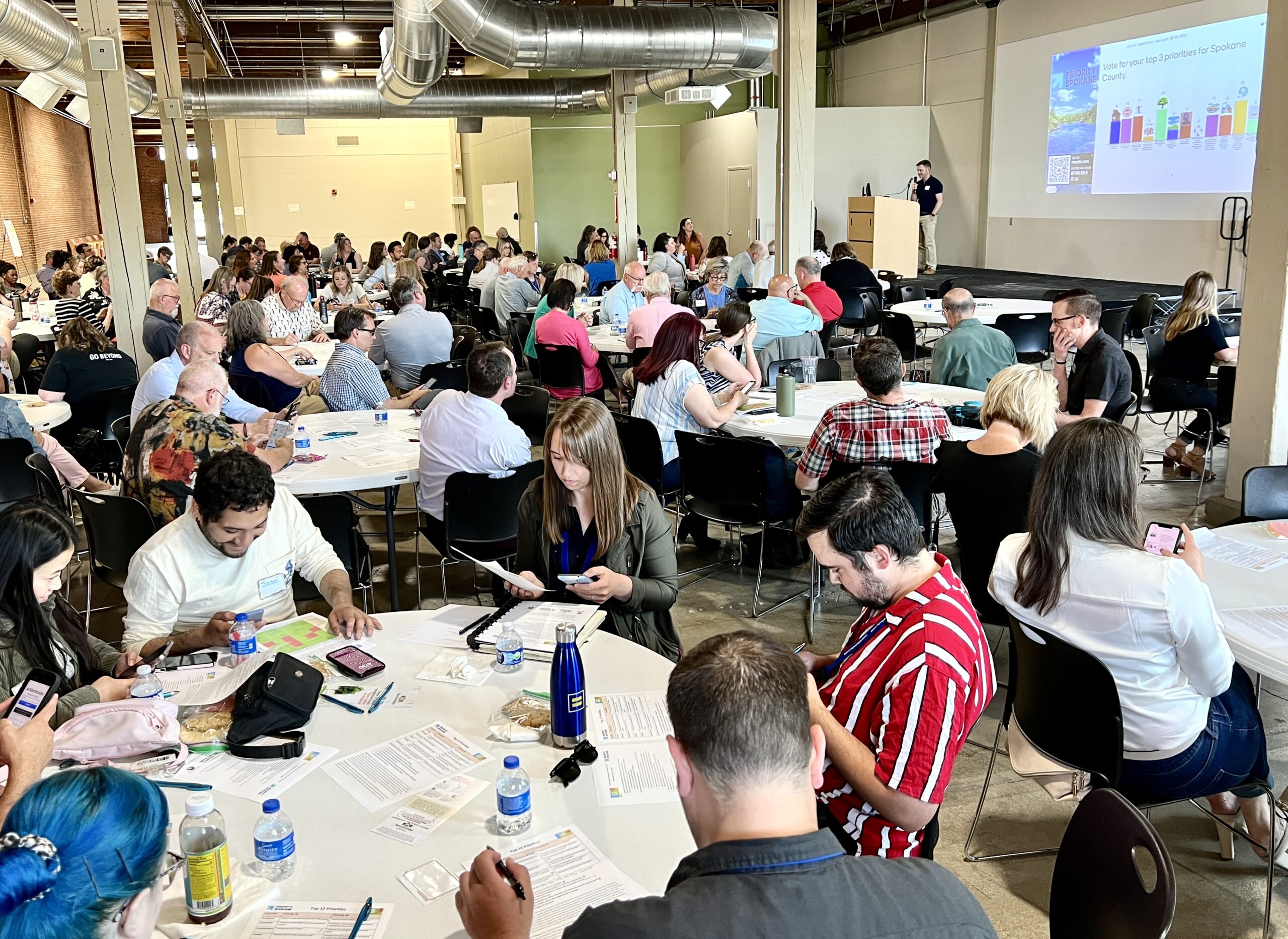EWU students' Spokane Trends’ Data Influences Community Action
Wednesday, June 14, 2023

EWU’s Institute for Public Policy and Economic Analysis is at the heart of a collaboration that is moving the needle on difficult problems and improving life for the community.
Known as Spokane Trends, the well-trafficked website, a collaboration of EWU, the City of Spokane, Providence Health Services, and Spokane Airports paints a vivid picture of life in Spokane County.
More than 200 measures delve into people, culture, recreation, economic vitality, education, environment, health, housing, public safety and transportation. Those numbers provide key details reflecting poverty, housing affordability, life expectancy and even the total miles of paved bicycle trails.
The website, which includes expandable sub-categories, is a tool for decision-makers in healthcare, government, business, non-profit and other sectors, as well as journalists and the general community.
Interns Miranda Carmona, Kate Guardarama-Diaz and Dylan Costinett look at data.
“I think that, for me, that has been one of the biggest rewards over the 20 years I’ve been doing this is just to see this tool is out there and is being used,” said Patrick Jones, PhD, executive director of the institute. The work wouldn’t be possible, he said, without the help of student interns and researcher Kelley Cullen, PhD, a policy analyst and economics faculty member at EWU.
Spokane Trends, started in 2004, is one of the longest running “trends” sites in the country. Part of that, Jones believes, is the institute’s collaborative approach.
Nearly all of the indicators on the Spokane Trends website reflect a community vote, done in partnership with Priority Spokane, a collective impact group of over 25 organizations. Greater Spokane Inc., Avista Utilities, United Way, local municipalities and fire districts, major healthcare providers and area universities are among the collaborating entities.
Every five years, Priority Spokane conducts a yearlong evaluation that results in a group vote to select three priority focus areas to work toward improving. This round of community assessment includes some statistics done in concert with Spokane Regional Health District as part of its requirement to conduct a community needs assessment every five years.
The district is one of many local entities using data gleaned in this all-encompassing research effort for required reporting to the state and federal government and even to funders.
“This is the fourth time we’ve gone through this pretty time-consuming, elaborate process to get a pulse of what Spokane residents would like to focus on,” Jones said.
This year’s Priority Pitch and Vote session, held on May 31 at Washington State University’s Spokane Center for Clinical Research and Simulation, brought together 185 people. The session capped off a year of meetings involving some 375 stakeholders and more than 70 data indicators. After hearing arguments in support of a dozen priorities, participants used cell phones to caste real-time votes.

Priority Spokane participants cast votes using cell phones with instantaneous results published on the overhead screen.
Top priorities included Increasing access to services and resources for patients with mental health needs, building capacity for childcare so parents can get back to work and increasing the tree canopy to improve air quality and combat climate change.
Ryan Oelrich, Priority Spokane’s executive director, said the group has made an impact on several pressing issues, among them helping to dramatically increase high school graduation rates.
After a 2009 community indicator showed that fewer than 60 percent of students attending Spokane Public Schools graduated from high school, Priority Spokane brought together a consortium of leading community organizations to develop strategies to keep students in school.
By 2013, graduation rates had increased to more than 80 percent, an achievement that earned Spokane County the Robert Wood Foundation’s Culture of Health Prize.
“I still get calls from organizations across the country that want to use our model to learn from what you all did,” Oelrich said.
Julie Honecamp has been involved with Priority Spokane for a decade. As chief executive officer of Spokane Neighborhood Action Partners (SNAP), a Spokane County nonprofit that operates 30 programs serving 40,000 people, her team uses Spokane Trends’ data for grant writing and to analyze community needs.
“I think it is a great way to distill down complexities. We use it when we are kind of scanning our environment to figure out where should we focus our efforts,” said Honecamp.
Over the years, the institute has been commissioned to create community indicators websites for Skagit, Chelan, Douglas, Grant, Yakima, Benton/Franklin, and Walla Walla-Columbia counties.
In addition, The Spokesman-Review runs a weekly community indicators graphic on the Sunday business section cover.
Jones said this year’s team included juniors and seniors, Kate Guardarama-Diaz, Dylan Costinett, Laura Velazquez, Liliya Kostenko and Miranda Carmona, who helped to add or replace 70 indicators -including 25 new metrics measuring race and ethnicity.
The overall changes reflect the landscape of today, Jones said. “We are so community driven and so responsive. That’s something that I’m quite proud of.”